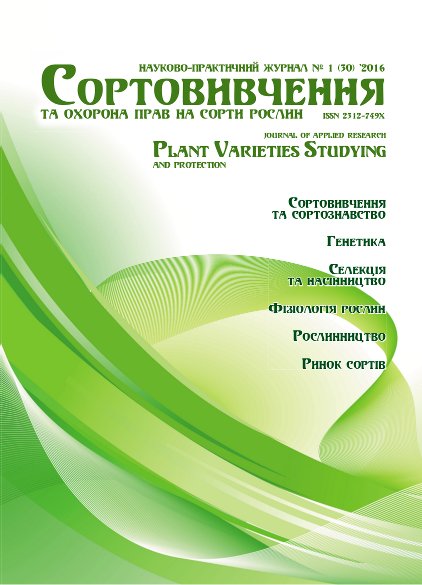Applying analysis of variance to determine stability of morphological and value for cultivation and use characteristics of Lactuca sativa var. longifolia L. variety of lettuce ‘Skarb’
DOI:
https://doi.org/10.21498/2518-1017.1(30).2016.61706Keywords:
Romaine lettuce, variety, identification, variation series, deviation, thresholds, characteristic stabilityAbstract
Purpose. Providing a scientific rationale for the practical application of analysis of variance elements to determine the range of morphological and value for cultivation and use (VCU) characteristics of Romaine lettuce ‘Skarb’ variety. Results. The Romaine lettuce ‘Skarb’ variety was identified by the type of display of quantitative (QN) identification characteristics. VCU characteristics of the var. longifolia L. varieties were determined and statistically processed. The author focused on practical application of histogram and variation curve of phenotype morphological characteristics when performing the uniformity test. The correlation between quantitative characteristics of lettuce leaf and head was observed when plant productivity was developing. Romaine lettuce yield value was verified statistically. Thresholds were established for the indices under study, confidence intervals were defined over the years of study. Conclusions. The use of Lewis stability factor (S.F. = Xmax/Xmin) allowed to establish the stability of each characteristic display. Practical application of the histogram and variation curve for determining code of display of quantitative morphological characters and the range of VCU characteristics of the Romaine lettuce ‘Skarb’ variety was scientifically grounded.
Downloads
References
Statystychnyy zbirnyk. Silske hospodarstvo Ukrainy v 2005 roci [Statistical Digest] (2006). Kyiv: Derzhavnyi komitet statystyky Ukrainy [in Ukrainian].
Pozniak, O. V. (2009). Deiaki aspekty suchasnoi kontseptsii shchodo riznovydnostei vydu Lactuca sativa L. [Some aspects of the modern concept dealing with the subvariety of species Lactuca sativa L.]. Suchasni aspekty vedennia silskoho hospodarstva: materialy III nauk.-prakt. konf. molodykh vchenykh [Modern aspects of farming: proceedings of the 3rd Science-to-practice conference of young scientists], 2009, 17 Febr., Prohres (pp. 60–63). Chernihiv: N.p. [in Ukrainian].
Bondarenko, H. L., & Yakovenko, K. I. (2001). Metodyka doslidnoi spravy v ovochivnytstvi i bashtannytstvi [Methods of testing in vegetable and melon cultivation]. Kharkiv: N.p. [in Ukrainian].
Dospekhov, B. A. (1985). Metodika polevogo opyta (s osnovami statisticheskoy obrabotki rezul’tatov issledovaniy) [Methods of field experiment (with the basics of statistical processing of research results)]. (5th ed., rev.). Moscow: Agropromizdat [in Russian].
Zaytsev, H. N. (1984). Matematycheskaya statystyka v eksperymentalnoy botanike [Mathematical statistic]. Moscow: Nauka [in Russian]. Moscow: Vysshaya shkola [in Russian].
Leschuk, N. V. (2007). Metodyka provedennia ekspertyzy sortiv salatu posivnoho (Lactuca sativa L.) na vidminnist, odnoridnist i stabilnist [Procedure of cutting lettuce varieties examination]. Okhorona prav na sorty roslyn [Protection of plant varieties rights], 3(2), 366–379 [in Ukrainian].
Horovoy, T. K., & Yakovenko, K. I. Sovremennye metody selektsii ovoshchnykh i bakhchevykh kultur [Modern methods of vegetable and melon and gourds breeding]. Kharkov: N.p. [in Ukrainian].
Downloads
Published
How to Cite
Issue
Section
License
Copyright (c) 2016 Ukrainian Institute for Plant Variety Examination

This work is licensed under a Creative Commons Attribution-ShareAlike 4.0 International License.
Starting in 2022, the copyright to the publication remains with the authors
Our journal abides by the CREATIVE COMMONS copyright rights and permissions for open access journals.
Authors, who are published in this journal, agree to the following conditions:
- The authors reserve the right to authorship of the work and pass the first publication right of this work to the journal under the terms of a Creative Commons Attribution License, which allows others to freely distribute the published research with the obligatory reference to the authors of the original work and the first publication of the work in this journal.
- The authors have the right to conclude separate supplement agreements that relate to non-exclusive work distribution in the form in which it has been published by the journal (for example, to upload the work to the online storage of the journal or publish it as part of a monograph), provided that the reference to the first publication of the work in this journal is included.

























 Ukrainian Institute for Plant Varieties Examination
Ukrainian Institute for Plant Varieties Examination  Селекційно-генетичний інститут
Селекційно-генетичний інститут Institute of Plant Physiology and Genetics of the National Academy of Sciences of Ukraine
Institute of Plant Physiology and Genetics of the National Academy of Sciences of Ukraine
 The National Academy of Agrarian Sciences of Ukraine
The National Academy of Agrarian Sciences of Ukraine